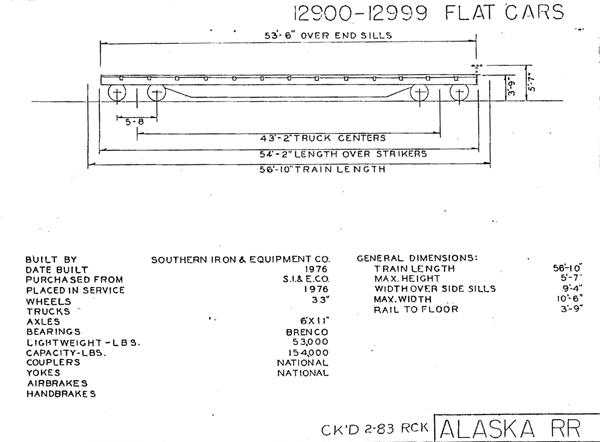
.
The Alaska Railroad purchased 100 flats from Southern Iron & Equipment
Co in 1976. These 75 ton cars were commonly used for COFC and piggy back service
and were originally rated for GS or General Service. The clearance drawing
below does not show the storage boxes built under the deck on each side to
hold the chocks and electrical service cables which originally connected these
cars and the climate controlled vans and trailers they carried to mid train
generator cars. The doors of these boxes later became the support for the lube
data. The boxes are evident in photos and measure 48" wide by 36" deep
and 18" high.
The cars were pressed into a variety of service over the years. Here they fitted with diapers and absorbents to handle the remains of a tank train derailment up north. Below they are shown in Whittier loaded with the precast sections of the Johansen Expressway overpass structures bound for Fairbanks.
These flats have a narrow 13" high side sill measured from the bottom of the deck. There are 13 stake pockets. The Athearn 60' flat car is a good starting point for a kit bash into 12900 flats. They are not currently offered in kit form and are not in production as of 2008 but you will find them as RTR with and without deck loads at your LHS.
The challenge is to reduce the car deck to 53'6" while retaining the 13 stake pockets and then reducing the side sill to 15", which is as close as we can get to the prototype 13" with this car.
1. Cut across the deck using the deck planks as guides in 8 places as follows:
a. Cut just outside of the first stake pocket on each end and then remove two planks from the short end sections.
b. Cut between stake pockets 6 and 7 in from each end and remove 1 plank at each location.
2. Square the cut ends and glue the 5 resulting deck sections together to arrive at the 54'2" length over the strikers.
3. Remove the cast on grab irons. Place a spacer on the inside of the side sill as a guide while filing the sill down to a depth of 15".
4. The prototype has truck centers 43' 2" apart. Reduce the underframe to match by cutting across the frame just outside the the second cross member from each end. Reduce the two end pieces in length until the desired 43'2" truck center on the bolster is achieved.
5. Remove the same total amount of material from one end of the car weight.
6. Now use ACC to assemble the deck, weight and frame as a sandwich while centering the frame.
From this point clean up the deck joints with a zona saw, and add the details: Tack boards, eight grab irons, four stirrup steps, cut levers and fabricate the storage boxes. Paint with mineral red and letter with the decals for this car from Randy Thompson at Roundhouse Hobbies. The Lube plate and ACI decals are from Microscale. Here is the finished model.
Temporary Bulkheads have been applied to one end on some of these cars and are used for pallet skids, containers and pipe loading.
The 12900 series cars are survivors. Of the 100 cars received in 1976, the 2008 roster shows 98 still in service dedicated for "Other COFC, Whittier COFC, Military Moves".
I plan to keep building ARR flats until I have at least one of each series. Should keep me busy until I am 102 since I keep finding photos of unique ones.
These write ups are really for
me, so I can remember what source car was used and what steps and materials
went into the project. I might want to
build a
string of them later. I share the results here on alaskarails.org in hopes
that other modelers will take the opportunity to document our railroad
history in models.